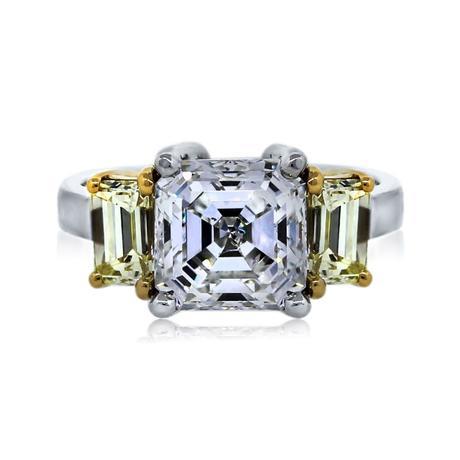About a week ago, I was waxing romantic about my adoration of fancy yellow diamonds. In particular, the emerald cut fancy yellow diamonds on either side of this ring.

These fancy yellow emerald cuts are a sight to behold – we never get fancy yellow step cut diamonds in the store. But why? Why are step cuts so rare in untreated fancy yellow diamonds? Well, it’s all about color, the biggest selling point of any fancy yellow diamond. In a white diamond, the cut is used to minimize the presence of any color. In a fancy yellow, the yellower, the fancier, the better.
Now, cut isn’t just the shape of a diamond, rather, it has to do with the way a diamond reflects and refracts light to display brilliance, fire, and color to the eye. A skilled diamond cutter will maximize the eye’s perception of color by using a different technique than he would with a colorless diamond. With a fancy cut like a radiant or cushion (two of the most popular fancy yellow diamond cuts) the pattern is very similar to a round brilliant, and it allows greater opportunity for the light to bounce off the stone’s facets, because there are more. In an emerald cut, there are fewer facets for the light to work with. So while it’s a great cut for showing off clarity, it can leave a yellow diamond desaturated. And when it comes to clarity in fancy diamonds – along with the other 4 C’s – it’s a different ball game from white diamonds.
Cut – Unlike white diamonds, the first priority of fancy yellows is color. So rather than using a cut to skillfully balance all the other grading criteria, a cutter will first look for the best way to maximize color (over clarity and carat weight.) For this reason, fancy shapes like cushion, oval, pear shape and the radiant I mentioned above take precedence over emerald cuts and round brilliants. An RB can display dazzling color, but the other shapes usually allow the cutter to create a larger diamond, creating less waste from the rough. A fancy yellow diamond’s cut is so important to its color that it can even transform diamonds that fall on the D-Z scale into looking like fancy yellows.
Clarity – When it comes to white diamonds, I usually caution buyers not to venture beyond the VS (very slightly included) clarity range to get a great deal on a truly beautiful stone. Anything else runs the risk of looking cloudy and dull. But when it comes to fancy yellows, that lovely sunny yellow hides a multitude of flaws. You can safely venture into SI (slightly included) territory and have it still look eye clean. You’d also be harder pressed to find a VS clarity fancy yellow because they’re rarer in nature, and therefore command a premium. As long as the inclusions aren’t smack on the diamond’s table and they don’t compromise its structure, you have more wiggle room here.
Color – It should come as no surprise, the color is the most important thing in a fancy colored diamond. Like I mentioned before, it takes precedence over even cut (which is always my most important of the 4 C’s!) The greater the intensity of color, the more valuable and desirable the diamond. It’s this criteria alone that easily explains why there are so few step cuts – they just don’t maximize the color like a fancy cut can.
Carat Weight – Again, in contrast to white diamonds, a cutter will forgo carat weight if it means making a cut that will give a fancy diamond more color. The objective is still to get your finished diamond’s weight as close to that of the rough as possible, but there are other factors at play.
So, moral of the story: If you see a step cut fancy yellow diamond, snap it up immediately. If you don’t have the means for that, at least try it on to admire and sear the memory into your brain.

